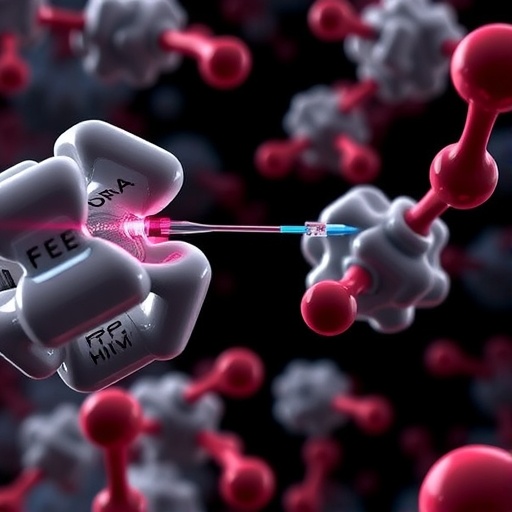In a groundbreaking study published in BMC Pediatrics, researchers have delved into the intricate dynamics of pediatric Hashimoto’s thyroiditis (HT), an autoimmune condition that predominantly affects the thyroid gland in children and adolescents. This condition, characterized by an underactive thyroid, has raised significant concern due to its increasing prevalence and potential for long-term complications if left untreated. The study, spearheaded by Kaba et al., sheds new light on how certain diagnostic tools, particularly the resistive index (RI), can enhance our understanding and management of this complex disease.
The resistive index, a parameter derived from Doppler ultrasound, has traditionally been used in adult populations to evaluate various vascular conditions. However, this study argues for its utility in pediatric settings, emphasizing that RI offers valuable insights into thyroid gland perfusion and inflammation. With pediatric HT presenting distinct clinical features and progression compared to adults, utilizing RI as a diagnostic tool could pave the way for earlier detection and more effective management of the condition in younger patients.
One of the pivotal aspects of this research is its focus on the potential impact of vitamin D treatment on the resistive index in children diagnosed with Hashimoto’s thyroiditis. Vitamin D is well-known for its role in immune function and has garnered attention for its possible therapeutic effects in various autoimmune diseases. The researchers explored the hypothesis that optimizing vitamin D levels could mitigate some of the thyroid-related dysfunctions observed in these young patients, potentially reflected in improved RI measurements.
The methodology employed in this study is particularly noteworthy. A cohort of pediatric patients diagnosed with Hashimoto’s thyroiditis was carefully selected. Comprehensive data were collected, including thyroid function tests, vitamin D levels, and resistive index measurements through advanced Doppler imaging techniques. By correlating these variables, the research aimed to establish a clearer link between vitamin D supplementation and improvements in thyroid vascularity and function, as indicated by changes in the RI.
The findings from Kaba et al. suggest a compelling relationship between vitamin D levels and the resistive index in children with Hashimoto’s thyroiditis. Not only did the study observe fluctuations in RI measurements post-vitamin D treatment, but it also noted an associated improvement in thyroid function among participants. This breakthrough could lead to revised protocols for diagnosing and managing pediatric HT, emphasizing the importance of monitoring vitamin D levels as part of a comprehensive treatment plan.
Moreover, this research highlights an essential shift in the understanding of pediatric autoimmune disorders. Traditionally, the management of conditions like Hashimoto’s thyroiditis may have relied heavily on hormone replacement therapy without addressing the underlying autoimmune component. The incorporation of vitamin D as a modifiable factor in treatment regimens could represent a significant advancement in the holistic approach to pediatric endocrinology.
As the medical community continues to grapple with the implications of autoimmune diseases in children, this study stands as a testament to the need for innovative diagnostic strategies. By leveraging modern imaging techniques and integrating findings from immunological research, practitioners can significantly enhance their ability to tailor treatments to individual patient needs. The insights gleaned from this study could significantly impact clinical practices, leading to earlier interventions and improved patient outcomes.
Emphasizing the importance of early diagnosis and intervention, Kaba et al. have sparked a necessary dialogue among healthcare professionals about the management of pediatric Hashimoto’s thyroiditis. Their findings challenge the status quo and encourage clinicians to consider the broader implications of vitamin D in autoimmune health. This research has opened the door for future studies investigating other potential therapeutic roles of vitamin D and its relationship with various aspects of immune health.
In conclusion, the study by Kaba et al. is a crucial step forward in our understanding of Hashimoto’s thyroiditis in pediatric populations. By establishing a link between resistive index and vitamin D treatment, it underscores the need for integrative approaches in the management of autoimmune diseases. As researchers continue to explore the complex interactions between hormones, the immune system, and overall health, it is clear that a multi-faceted perspective is essential for advancing pediatric care.
Such innovative research not only holds the promise for improved clinical outcomes but also raises public awareness about the importance of early diagnosis and treatment of thyroid conditions in children. Ensuring adequate vitamin D levels should be prioritized, not just for its role in bone health, but for its potential broader implications in pediatric endocrinology.
As we look to the future, the medical community must remain vigilant in monitoring emerging studies like this one. The evolving narrative surrounding Hashimoto’s thyroiditis and the significance of diagnostic tools like the resistive index will undoubtedly shape clinical practices and patient care pathways. The implications of this research extend beyond the confines of academic discussion, urging both healthcare providers and families to engage actively in managing thyroid health from a young age.
Subject of Research:
Pediatric Hashimoto’s Thyroiditis, Resistive Index, Vitamin D Treatment
Article Title:
Evaluating the role of resistive index in pediatric Hashimoto’s thyroiditis diagnosis and the impact of vitamin D treatment on resistive index
Article References:
Kaba, S., Doğan, M., Özkaçmaz, S. et al. Evaluating the role of resistive index in pediatric Hashimoto’s thyroiditis diagnosis and the impact of vitamin D treatment on resistive index. BMC Pediatr 25, 944 (2025). https://doi.org/10.1186/s12887-025-06330-z
Image Credits:
AI Generated
DOI:
https://doi.org/10.1186/s12887-025-06330-z
Keywords:
Pediatric Hashimoto’s Thyroiditis, Resistive Index, Vitamin D Treatment, Autoimmunity, Thyroid Health
Tags: autoimmune thyroid disease in childrenclinical features of pediatric HTDoppler ultrasound in pediatric diagnosticsearly detection of Hashimoto’s thyroiditislong-term complications of untreated Hashimoto’spediatric autoimmune conditions managementpediatric Hashimoto’s thyroiditisresistance index utility in pediatricsresistive index in thyroid evaluationthyroid gland perfusion assessmentthyroid inflammation and vitamin Dvitamin D treatment and autoimmune diseases





